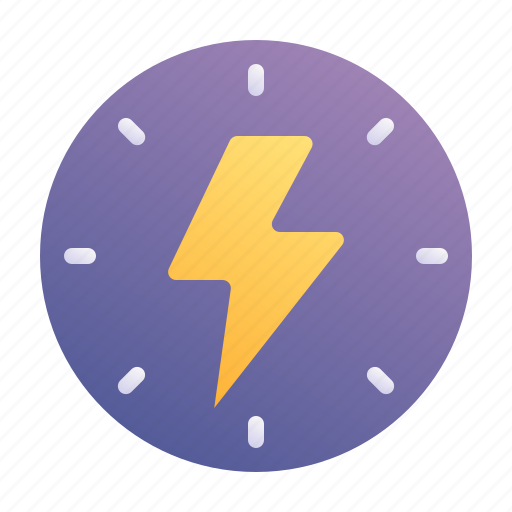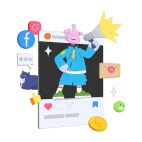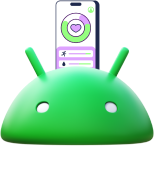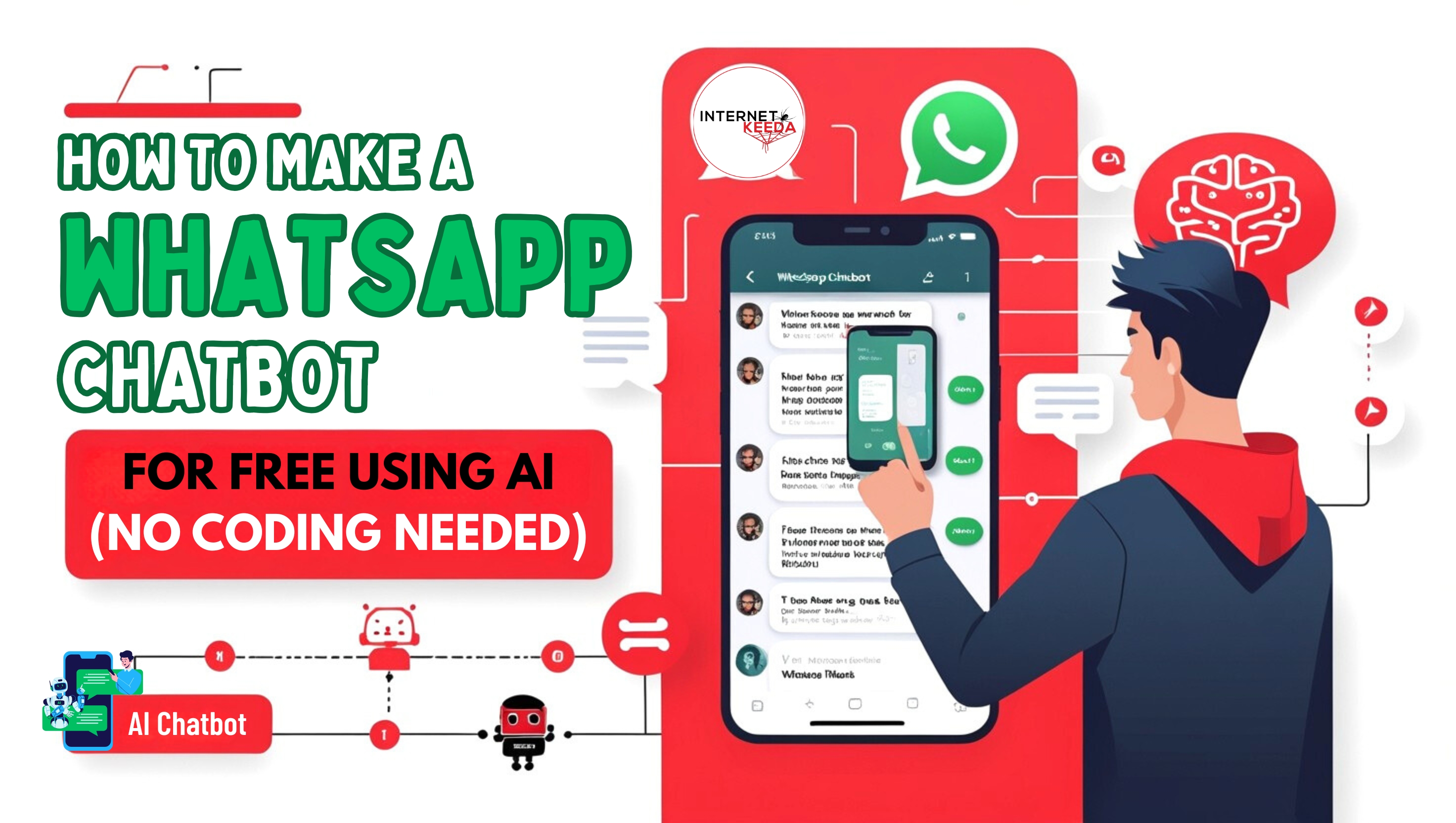You don’t need to be a techie or spend a fortune to create a smart, automated WhatsApp chatbot in 2025. In fact, with the latest AI tools, you can build one in under 10 minutes — no coding, no developers, no stress.
Whether you're running a small business, handling support queries, or just want to automate responses while you sleep, a WhatsApp bot can save time and improve customer experience.
This guide will walk you through how to create a WhatsApp chatbot for free, powered by AI, and tailored for your specific use all without touching a single line of code.
Ready to build yours?
What Is a WhatsApp Chatbot and How Does It Work?
A WhatsApp chatbot is an automated system that can reply to users on WhatsApp instantly, just like a human would, but without you having to be online. It can answer questions, send images or PDFs, collect customer details, run surveys, share product links, and even handle basic support queries.
Instead of manually typing out responses all day, the chatbot does the job for you. And with AI, it doesn’t just follow a fixed script. It can understand questions, pick up intent, and respond more naturally like a real conversation.
Here’s how it works at a basic level:
- A customer sends you a message or triggers a bot by clicking a link or scanning a QR code.
- The bot reads the input and replies based on predefined logic or an AI-generated response.
- You can add menus, buttons, or keywords to guide the user through.
- It runs 24/7, so you never miss a lead or query again.
If you’ve ever received an instant reply after messaging a business on WhatsApp, chances are that was a chatbot in action.
Why Use a WhatsApp Chatbot in 2025? (And What You Can Do With It)
WhatsApp isn’t just for chatting with friends anymore, it's the place where customers expect instant answers, updates, and personal service. In 2025, if you're not automating at least part of your communication, you're falling behind.
A WhatsApp chatbot powered by AI can do far more than just auto-reply “Hi, we’ll get back to you.” It can help you capture leads, close sales, reduce support tickets, and scale conversations in ways no human team can keep up with manually.
Here’s what you can do with a smart WhatsApp chatbot today:
1. Auto-respond to FAQs in seconds
Tired of typing the same responses over and over? Set your bot to answer things like:
- "What are your prices?"
- "Where’s my order?"
- "Do you deliver on weekends?"
The bot replies instantly without delay, without burnout.
2. Capture leads while you sleep
Use your bot to ask for the customer’s name, email, and what they’re looking for. All of it gets saved automatically, so you can follow up later or send it directly to a product or sales page.
3. Send product recommendations
Let the chatbot act as a mini sales assistant. Based on what the user asks or selects, it can suggest items, provide links, share images, and drive them toward purchase.
4. Run customer support 24/7
Answer common queries, collect issue details, and even create tickets for your team. AI makes it easier to understand questions in different ways, even if users don’t phrase them perfectly.
5. Boost your engagement and conversions
People reply more when they feel heard instantly. Whether you’re running a campaign, collecting feedback, or launching a new product, a bot can help keep the conversation alive without you manually replying to hundreds of messages.
6. Save hours every week
One well-built bot can handle hundreds (or thousands) of chats. That’s hours saved every week, time you can put into growth instead of busywork.
And the best part? You don’t need to pay for expensive platforms or hire a developer. AI tools have made it insanely easy to build a WhatsApp bot by yourself in just a few steps.
How to Build a WhatsApp Chatbot for Free Without Coding (Step-by-Step Guide)
You don’t need to be a developer to build a WhatsApp chatbot anymore. Thanks to AI tools and no-code platforms, setting up your chatbot is something anyone can do in a couple of hours or less. Whether you're a solopreneur, freelancer, agency owner, or small business, this guide walks you through the steps to create a working chatbot for free.
Let’s break it down.
Step 1: Set up your WhatsApp Business account
If you haven’t already, download the WhatsApp Business app from the Play Store or App Store. It gives you features like quick replies, catalog listings, and basic automation.
Make sure to:
- Use a dedicated number for your business
- Add a profile picture and business description
- Turn on away messages and greeting messages
This is your foundation. Once that’s done, it’s time to bring in AI.
Step 2: Choose a free WhatsApp chatbot platform
There are a few tools that let you build a chatbot without touching a single line of code. Some of the top free options in 2025 include:
- Kompose by Kommunicate
Offers simple drag-and-drop bot building. You can integrate GPT-style AI replies into WhatsApp using their free plan with limited messages per month. - Zoko's WhatsApp chatbot builder
Best suited for e-commerce and D2C brands. It lets you use basic bots and broadcast flows for free, though advanced features are behind a paywall. - WA Web Plus or WhatsAuto (Browser-based workarounds)
These tools use browser automation and keyword triggers to simulate chatbot behavior, good for early-stage use or testing.
Pick one that suits your needs. For example, Kompose is great if you want AI-powered conversations, while Zoko is better for catalog-based responses.
Step 3: Connect your WhatsApp number
Depending on the tool you choose, you may need to connect your number via QR code or register for the WhatsApp Cloud API (which is free to use if you keep usage under Meta’s daily messaging limits).
Some tools guide you through the Cloud API setup. Others let you scan a QR code and instantly sync your WhatsApp Web account to begin automation.
Step 4: Design your chatbot flow
This is where your creativity kicks in. Think about what users commonly ask and how your bot should respond.
Use templates like:
- “Hi, how can I help you today? Please type 1 for pricing, 2 for product info, or 3 to chat with our team.”
- “Thanks for your message. Our team is currently unavailable, but here's what we can help you with right now.”
Then map out:
- FAQs and answers
- Product or service recommendations
- Lead capture questions (Name, Email, Interest)
- Call-to-action links or catalog items
Use AI if the tool allows it. Let it read incoming messages and respond naturally using trained data or language understanding. You can even preload it with your website FAQs and let the bot generate contextual answers.
Step 5: Test your bot in real-time
Before going live, always test your chatbot. Use a separate phone or account to send messages and see how the bot replies. Try different keywords, casual phrases, and typos. This will help you improve the experience and make the replies more human-like.
Make sure the bot:
- Responds quickly and accurately
- Handles multiple queries in a row
- Doesn’t loop or get stuck
- Offers a way to talk to a human if needed
Step 6: Go live and promote it
Once everything’s working, start using the bot in real conversations. You can:
- Add your WhatsApp link to your website and Instagram bio
- Include a WhatsApp chat button in your email signature
- Send the link to leads who message you on other platforms
- Set up click-to-chat WhatsApp ads for high-converting campaigns
Now your chatbot is doing the work for you. Whether you're generating leads at midnight, answering product questions in real time, or just saving yourself from endless DMs, this setup puts you in control.
How to Train Your WhatsApp Chatbot with AI for Smarter Conversations
A basic chatbot is fine for simple FAQs, but if you want yours to feel more like a real assistant and less like a menu, AI is the secret. When you train your WhatsApp chatbot with AI, it can understand natural language, catch variations in questions, and even handle spelling mistakes.
This is what separates a “press 1, press 2” bot from a helpful, friendly experience that impresses customers.
Let’s look at how to train your chatbot step by step.
1. Collect Common Questions First
Before you plug in any AI, you need raw material. Start by gathering the actual questions your customers ask.
You can:
- Export your WhatsApp chat history to see recurring phrases
- Check your email and DMs for common topics
- Look at your website's live chat logs
Write them out as a list. For example:
- What are your prices?
- Do you deliver on weekends?
- How long does shipping take?
- Can I pay on delivery?
Aim for at least 20–30 examples to cover the basics.
2. Choose an AI Engine That Understands Language
Most modern WhatsApp chatbot builders integrate AI language models. Look for tools that mention:
- Natural Language Processing (NLP)
- GPT or OpenAI integration
- AI-powered intent recognition
Kompose by Kommunicate, for example, can train its bot with your sample questions. When users type variations like “When will it arrive?” or “How fast is shipping?” the bot understands they all mean the same thing.
3. Map Intents to Clear Answers
Once your tool recognizes questions, you must connect them to replies.
This is called mapping “intents.”
Example:
Intent: Shipping Time
Sample Questions:
- How long does delivery take?
- When will my order arrive?
- Delivery time please
Bot Reply:
“Our standard delivery takes 3–5 business days. Express shipping is available at checkout.”
This way, no matter how someone asks, they get the same clear answer.
4. Train and Test the AI
Most platforms have a “Train Bot” button. When you click it, your bot learns to recognize all the phrases you added.
Then, test it by typing variations:
- “Delivery duration?”
- “How many days is shipping?”
- “When do you send orders?”
Check if it matches the correct intent and replies properly. If not, add more examples and retrain.
5. Keep Improving Over Time
AI chatbots get smarter the more they interact with real customers. Every month or so, look at your chatbot logs.
Ask yourself:
- Are there questions it keeps failing to answer?
- Are there replies that sound robotic?
- Can you merge or improve any intents?
Add new phrases, tweak the wording, and retrain. This keeps your bot fresh and makes conversations feel natural.
6. Add Fallback and Human Handoff
Even the best AI bot won’t get it right 100% of the time. That’s why you need a fallback response.
Example:
“Sorry, I didn’t quite understand that. Can you rephrase your question or tap the button below to chat with a team member?”
This makes sure no conversation ends in frustration.
Pro Tip:
Some AI tools let you plug in your website’s FAQ URL or paste your help docs. The AI can then scan all that information and generate answers automatically. This saves hours of manual setup.
AI doesn’t have to be complicated. With the right platform and a little setup, you can create a WhatsApp chatbot that understands real questions and answers in a friendly, helpful tone.
How to Promote Your WhatsApp Chatbot and Get People to Use It
Creating a chatbot is only half the battle. To truly make it valuable, you need real people engaging with it. That means showing your audience when, where, and how they can use it.
The good news? You don’t need a big ad budget. With a few smart placements and tactics, your chatbot can become the go-to support channel for your business.
Here’s how to get users talking to your bot from day one:
1. Add a WhatsApp Chat Button to Your Website
Your website is probably where most visitors learn about you, so it’s the perfect place to showcase your chatbot.
Use a floating WhatsApp icon in the bottom corner, or embed a “Chat with us on WhatsApp” button near product pages, the FAQ, or your pricing section.
Make sure it links directly to your bot using a click-to-chat link like this:
https://wa.me/91XXXXXXXXXX?text=Hi%20there!
Bonus: Some chatbot platforms give you custom links that trigger a specific flow when clicked. For example, a button that says “Ask about pricing” could take the user right into that chatbot conversation.
2. Promote It in Your Instagram Bio and Stories
If you have a strong Instagram presence, put your WhatsApp chatbot front and center. Replace the link in your bio with a direct WhatsApp link, or use a link-in-bio tool like Linktree or Beacons to feature it.
Create Story Highlights called “Order Help” or “Chat Support” and add swipe-up links (or link stickers) to your chatbot.
You can even run Stories like:
“Too many DMs? Just WhatsApp us! Tap here to chat with our bot.”
It feels casual, but drives traffic straight to your chatbot.
3. Use Click-to-WhatsApp Ads (Even With a Small Budget)
Facebook and Instagram ads can send users directly to your chatbot on WhatsApp. When someone clicks the ad, it opens their WhatsApp app with a pre-filled message.
You don’t need a huge budget. Just ₹300–₹500 per day targeting people who recently visited your website or engaged with your Instagram posts is enough to test.
Example pre-filled message:
“Hi, I’d like to know more about your skincare range.”
Once they hit send, your chatbot can instantly reply and guide them through the buying process.
4. Include Chatbot Links in Order Confirmations and Emails
Your customers are already opening your emails, so give them a reason to chat with your bot.
Here’s where to insert the link:
- Order confirmation email: “Need to make changes? Tap here to talk to our WhatsApp assistant.”
- Shipping updates: “Track your order anytime via WhatsApp here.”
- Newsletter: “Have a question? Chat with our bot 24/7.”
It builds a habit of using WhatsApp instead of emailing or calling.
5. Place a QR Code on Packaging or Storefronts
If you sell physical products or run a local store, don’t forget offline promotion. Generate a WhatsApp QR code that opens your bot and print it on packaging, receipts, flyers, or posters.
Text above it could say:
“Need help? Scan to chat with our assistant on WhatsApp.”
This works great for post-sale support, returns, or gathering feedback.
6. Use WhatsApp Broadcasts to Re-Engage Users
Once someone chats with your bot, you have a limited 24-hour window to reply. But if they opt in to receive updates, you can also send them broadcast messages.
Let users know they’ll receive order updates, special offers, or early product access if they tap the “Get Alerts on WhatsApp” button.
Then, you can send helpful updates that feel personal, like:
- “Hi Riya, we’re launching a new design this Friday. Want early access?”
- “Still thinking about the Vitamin C Serum? Tap to chat with our expert.”
Your bot can handle replies and guide them back into the funnel.
Real Talk: People Won’t Use It If You Don’t Show It
Even the smartest WhatsApp chatbot will sit unused if no one knows it exists. Promotion is just as important as setup.
You’ve already done the hard part by building the chatbot. Now, treat it like any product launch. Show it off. Make it easy to access. Give people a reason to try it.
How to Handle WhatsApp Chatbot Conversations Without Frustrating Users
A chatbot that responds instantly is great. But a chatbot that actually helps people without annoying them? That’s what builds trust and loyalty.
Most users don’t care if they’re talking to a bot or a human. They care about whether they’re getting the right answer, fast, and without confusion. If your bot feels like a broken loop or keeps asking irrelevant questions, people will leave and worse, they might block you.
Let’s fix that. Here’s how to make your WhatsApp chatbot feel smart, helpful, and human without trying too hard.
1. Let Users Know They’re Talking to a Bot
It might sound counterintuitive, but pretending your bot is human usually backfires. When someone realizes midway through a chat that they’re not talking to a real person, trust drops.
Instead, be upfront.
Start your flow with something like:
“Hey, I’m Zara, your virtual assistant. I’ll guide you through this quickly. You can type ‘human’ anytime if you want to chat with our team.”
It sets clear expectations, and most people will still engage without issue.
2. Offer Quick Replies and Buttons Instead of Long Text
WhatsApp is not a reading app. If your chatbot sends three long paragraphs in a row, people are going to swipe back and leave.
Instead, break things down into short, clean messages and use Quick Reply Buttons wherever possible. These buttons let users choose from 2–3 simple options with one tap.
Example:
Bot: “What do you want help with today?”
- Place an Order
- Track My Package
- Talk to a Human
This makes the interaction feel fast and smooth. No typing required, and no confusion.
3. Make Sure Users Can Exit or Reset the Flow
Sometimes, users tap the wrong button. Or they get stuck. Your chatbot should always offer a way to go back, start over, or get human help.
Add commands like:
- Type “menu” to return to the main options
- Type “help” to talk to a team member
- Type “restart” to begin again
This gives users a safety net, and makes the chatbot feel more flexible.
4. Handle Common Spelling Mistakes and Keywords
Not everyone types perfectly, especially on mobile. Your bot should recognize common variations like:
- “order” / “order status” / “track order” / “ordr”
- “price” / “cost” / “how much”
Use AI-based tools or keyword matching with synonyms and spelling variations to keep the flow from breaking.
The best chatbot platforms allow you to add multiple triggers for the same response, so you’re not relying on exact matches.
5. Use Delays and Typing Indicators for a Natural Feel
Don’t blast users with six instant replies. Add short delays between messages and use WhatsApp’s typing indicator to simulate a human conversation.
For example:
- Message 1: “Got it! Let me check that for you.”
- [3-second delay with typing bubble]
- Message 2: “Your order is on the way and should arrive by Tuesday.”
This creates a rhythm that feels more conversational and less robotic.
6. Don’t Be Over-Smart: Keep it Simple
Sometimes, businesses try to build overly complex bots that attempt to predict everything a user might say. The result? Confusion, wrong answers, and frustration.
Stick to clear, well-structured flows based on what users actually need. That usually includes:
- Placing an order
- Tracking delivery
- Asking about pricing
- Canceling or changing orders
- Talking to a human
If you cover these smoothly, your bot is already doing 90% of the work.
7. Always Give the Option to Talk to a Real Person
This one’s non-negotiable. No matter how good your bot is, some users will want a human. Don’t hide the “talk to human” option behind five menus.
Make it easy. Include it on the main menu. Train your team to respond fast when someone types “agent” or “support.”
Remember, the chatbot’s job is to assist, not replace. The best results happen when the bot filters easy tasks and your team handles the rest.
How to Track and Improve Your WhatsApp Chatbot’s Performance
Creating a WhatsApp chatbot is only the first step. What really makes it successful is how well it performs and that depends on how closely you track, measure, and improve it over time.
Most small businesses launch a chatbot and leave it running for months without checking whether it's helping or hurting the user experience. That’s a mistake.
Here’s how you can monitor your WhatsApp chatbot’s performance and continuously make it smarter using real data and feedback.
1. Start with the Right Metrics
There’s no point in guessing. You need to set clear performance indicators that tell you whether your chatbot is actually working.
Here are some of the most useful ones to track:
- Open Rate: How many people open your WhatsApp message. (WhatsApp usually has higher open rates than email—above 85%.)
- Click Rate: How many people tap on a link or button.
- Conversation Completion Rate: How many users complete the chatbot flow (e.g., finish placing an order, make a booking, or submit a form).
- Drop-off Points: Where users leave the chat or stop responding.
- Live Agent Handoff Rate: How often users request human support.
- User Satisfaction Score (CSAT): A simple feedback prompt at the end like “Was this helpful? Yes/No” gives you a quick pulse on how the bot is performing.
Keep track of these weekly. Even a small change in flow can affect drop-offs or conversions.
2. Use Analytics Tools from Your Chatbot Platform
Most modern WhatsApp chatbot platforms offer built-in dashboards that show:
- Number of conversations started
- User response rates
- Most clicked buttons
- Time of day when users are most active
- Keywords that triggered each flow
If your platform doesn’t show these, consider switching to one that does. Without analytics, you’re flying blind.
Some top-tier platforms even allow heatmaps or funnel-style views to show exactly where users are dropping off.
3. Record and Review Real Conversations
One of the fastest ways to improve your bot is to look at real chats between users and the chatbot. These transcripts are gold.
Here’s what to look for:
- Where users get confused or ask the same question repeatedly
- Where the chatbot fails to understand an input
- Where users type random keywords that don’t match any flows
- Where people keep typing “hello,” “human,” or “please help,” that usually signals frustration
Based on this, you can edit your bot’s flows, add better prompts, or simplify the language.
4. Improve Based on Feedback, Not Assumptions
Don’t assume what users want. Let them tell you.
At the end of every conversation, you can add a quick prompt like:
“Was this helpful?”
👍 Yes
👎 No
If a user selects “No,” follow up with:
“Thanks for the feedback. Anything we can do better?”
Some will type out useful replies like “I couldn’t find the tracking info” or “The bot didn’t understand my question.”
This helps you refine your chatbot and make it smarter over time without guessing.
5. Keep Updating Your Chatbot with Fresh FAQs
As your business grows or seasons change, your chatbot flows should evolve too.
For example:
- During holidays, add flows about delivery delays, discounts, or holiday hours.
- If you launch a new product, update your “Place Order” flow to include it.
- If users keep asking about a new service, add a dedicated response or submenu.
A chatbot is not a one-time project. Think of it as an evolving part of your customer service team.
6. Run A/B Tests for Better Results
Want to see if a different welcome message performs better? Or if shorter text boosts completion?
Run A/B tests.
Some chatbot platforms allow you to test two or more versions of the same flow and measure which one converts better. For example:
- Version A: “Hi, how can I help?”
- Version B: “Welcome! Ready to get started? Tap an option below.”
Track which version leads to more completed conversations or fewer drop-offs, then keep improving from there.
7. Set Up Alerts for When Something Goes Wrong
Even great bots break. Maybe a flow doesn’t trigger. Maybe a button link is outdated. Maybe users are stuck in a loop.
Set up error alerts inside your chatbot platform so your team is notified when:
- A user gets no response
- The bot fails to reply
- A flow is triggered too often without results
This helps you respond fast before users get frustrated.
Final Thoughts: You Don’t Need to Be a Coder to Build a Powerful WhatsApp Chatbot
Gone are the days when building a chatbot required a tech team or complex programming. With AI-powered tools now available for free, even solo entrepreneurs and small business owners can set up automated WhatsApp conversations that delight customers and drive real results.
Whether you want to answer FAQs, qualify leads, send product updates, or recover abandoned carts, your WhatsApp chatbot can do the job if you design it thoughtfully and keep improving it over time.
Start small. Keep it simple. Focus on real customer needs. And as you grow, your chatbot will grow with you.
The best part? You can do all of this today without spending money or writing a single line of code.
So go ahead and start building your free AI-powered WhatsApp chatbot. Your future customers are waiting.
 Bundles
Bundles Flash Sales
Flash Sales






















Comments (0)